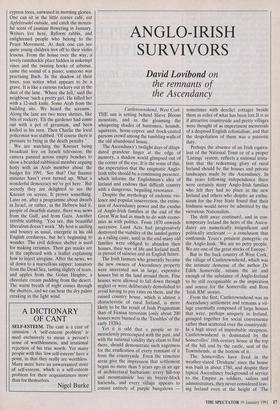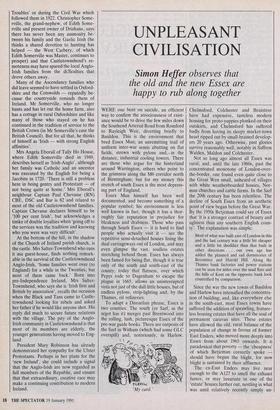ANGLO-IRISH SURVIVORS
David Lovibond on
the remnants of the Ascendancy
Castletownshend, West Cork THE sun is setting behind Slieve Bloom mountain, and in the gloaming the whispering shades of huntsmen, hounds, squireens, horse-copers and frock-coated parsons crowd among the tumbling walls of the old abandoned house.
The Ascendancy's twilight days of dilapi- dated grandeur linger at the edge of memory, a shadow world glimpsed out of the corner of the eye. It is the sense of this, the expectation that the enigmatic Anglo- Irish tribe should be a continuing presence, which informs the Englishman's idea of Ireland and endows that difficult country with a dangerous, beguiling resonance. Despite the mythology of endemic vio- lence and popular insurrection, the extinc- tion of Ascendancy power and the exodus of Anglo-Irish families at the end of the Great War had as much to do with econo- mics as with politics. From 1870 onwards successive Land Acts had progressively destroyed the viability of the landed gentry as a ruling caste, until in the end many old families were obliged to abandon their houses, their way of life and Ireland itself, in pursuit of salaries and an English future.
The Irish farmers who generally became the new owners of Ascendancy property were interested not in large, expensive houses but in the land around them. Fine houses were allowed to fall down through neglect or were deliberately demolished to avoid having to pay rates on them, and the ruined country house, which is almost a characteristic of rural Ireland, is more likely to be the result of Irish Pragmatism than of Fenian terrorism (only about 200 houses were burned in the 'Troubles' of the early 1920s).
Yet it is odd that a people so re- morselessly preoccupied with the past, and with the national validity they claim to find there, should demonstrate such eagerness for the eradication of every remnant of it from the countryside. Even the remotest areas give the impression that settlement began no more than 5 years ago in an age of architectural barbarism: every hill-top and mountainside has its breeze-block hacienda, and every village appears to consist entirely of purple bungalows — sometimes with derelict cottages beside them as relics of what has been lost.It is as if attractive countryside and pretty villages were thought of as impertinent memorials of a despised English colonialism, and that the despoliation of them was a patriotic duty.
Perhaps the absence of an Irish equiva- lent of the National Trust or of a proper 'Listings' system, reflects a national irrita- tion that the redeeming glory of rural Ireland should be the houses and private landscapes made by the Ascendancy. In the years following independence there were certainly many Anglo-Irish families who felt they had no place in the new Ireland and others who despite an enthu- siasm for the Free State found that their Irishness would never be admitted by the victorious Nationalists.
The drift away continued, and in con- temporary Ireland the heirs of the Ascen- dancy are numerically insignificant and politically irrelevant — a conclusion that confounds Yeats's petulent panegyric on the Anglo-Irish: 'We are no petty people. We are one of the great stocks of Europe.'
But in the back country of West Cork, the village of Castletownshend, which was the intimate demense of the author Dr Edith Somerville, retains the air and enough of the substance of Anglo-Ireland to be still recognisable as the inspiration and source for the Somerville and Ross 'Irish RM' stories.
From the first, Castletownshend was an Ascendancy settlement and remains a vil- lage essentially composed of large houses that were, perhaps uniquely in Ireland, grouped together for social convenience rather than scattered over the countryside. In a high street of improbable steepness, Castletownshend is dominated by the Somervilles' 18th-century house at the top of the hill and by the castle, seat of the Townshends, at the bottom of it.
The Somervilles have lived in the weather-slated 'Drishane' since the house was built in about 1780, and despite their typical Ascendancy background of service to the Empire as soldiers, sailors and administrators, they never considered leav- ing Ireland even at the height of 'The Troubles' or during the Civil War which followed them in 1922. Christopher Some- rville, the grand-nephew, of Edith Some- rville and present owner of Drishane, says there has never been any animosity be- tween his family and the Gaelic Irish (he thinks a shared devotion to hunting has helped — the West Carbery, of which Edith Somerville was Master, continues to prosper) and that Castletownshend's re- moteness may have spared the local Anglo- Irish families from the difficulties that drove others away.
Many of the Ascendancy families who did leave seemed to have settled in Oxford- shire and the Cotswolds — reputedly be- cause the countryside reminds them of Ireland. Mr Somerville, who no longer hunts and has let out the home farm, also has a cottage in rural Oxfordshire and like many of those who stayed on he has continued in the tradition of service to the British Crown (in Mr Somerville's case the British Council). But for all that, he thinks of himself as 'Irish — with strong English affinities'.
Mrs Angela Eborall of Tally Ho House, where Edith Somerville died in 1949, describes herself as 'Irish-Anglo', although her family was Catholic and an ancestor was executed by the English for being a Jacobite in 1720. 'There is still a problem here in being gentry and Protestant — of not being quite at home.' Mrs Eborall's neighbour Captain Paul Chevasse (RN) CBE, DSC and Bar is 82 and related to most of the old Castletownshend families. Captain Chevasse declares himself to be '100 per cent Irish', but acknowledges a timke of double loyalties when 'going off to the services was the tradition and knowing who you were was very difficult'.
At the bottom of the hill, in the shadow of the Church of Ireland parish church, is the castle. Mrs Salter-Townshend who runs it asa guest-house, finds nothing remark- able in the survival of the Castletownshend Anglo-Irish, 'Some families went over (to England) for a while in the Twenties, but most of them came back.' Born into pre-Independence Ireland, Mrs Salter- Townshend, who says she is 'Irish first and British by association', recalls the occasion when the Black and Tans came to Castle- townshend looking for rebels and asked her father if he would like anyone shot. His reply did much to secure future relations with the village. The pity of the Anglo- Irish community in Castletownshend is that most of its members are elderly, the younger generations having moved to Eng- land.
President Mary Robinson has already demonstrated her sympathy for the Ulster Protestants. Perhaps in her plans for the `new Ireland', she could include a signal that the Anglo-Irish are now regarded as full members of the Republic, and ensure that that extraordinary, creative race may make a continuing contribution to modern Ireland.



















































 Previous page
Previous page